History Byte #01: The Colonial Club
📌 The old Colonial Club in Benque Viejo was a two-story, wooden structure that served as a saloon and dance hall. On a summer evening in the 1930s the upstairs veranda gave in to the crowds. Several persons were injured as they fell on those who had gathered in the saloon below. The Mopán Polyclinic now stands at the site of the Colonial Club.
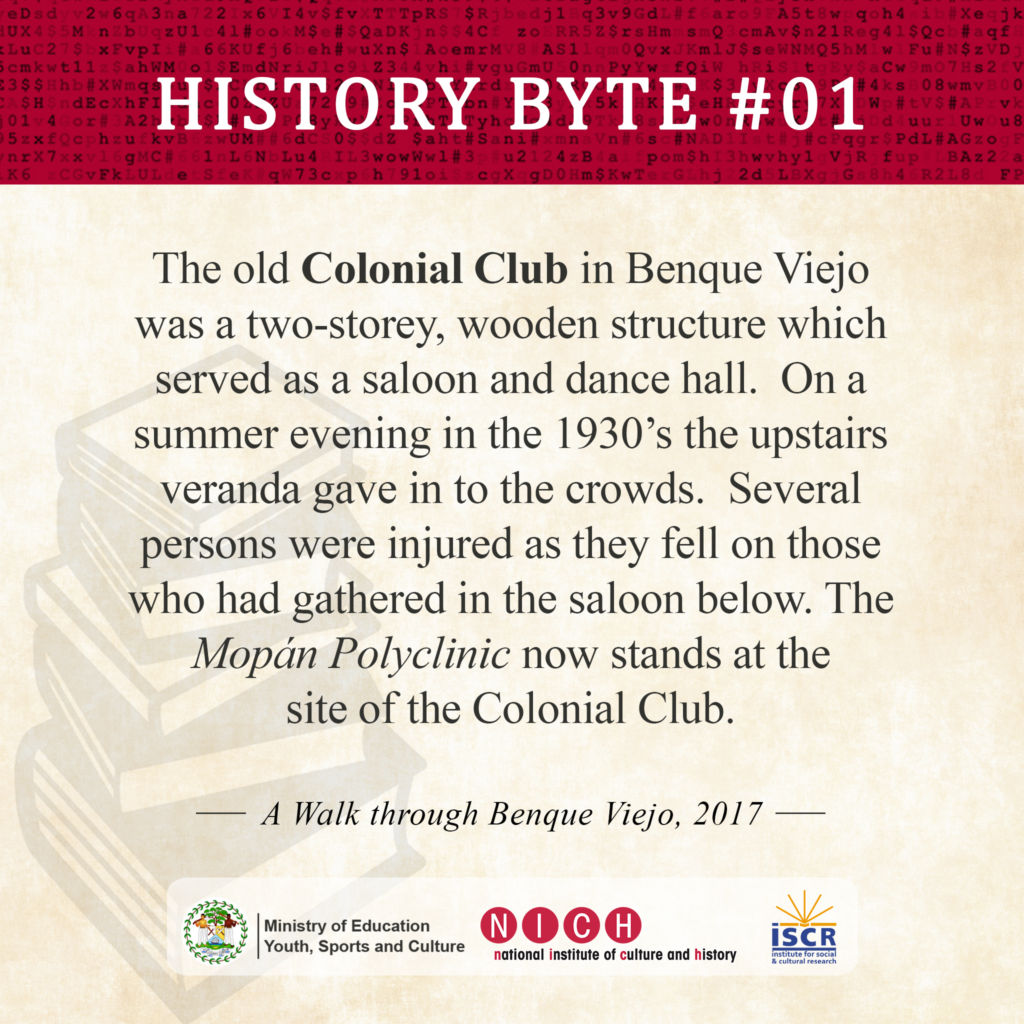
History byte #02: La Fiesta de la Santa Cruz
Do you know about La Fiesta de la Santa Cruz?
📌In the traditional Catholic calendar, 3rd May marked the discovery of relics associated with Christ’s passion while in Jerusalem.
📌During these events, the novena began around the 24 April and ended on 3rd May. On the evening of 2nd May, the men dug and prepared a hole for the pib.
📌The village alcalde played a secondary role in the affair and along with others ensured that the celebration was held and that the priest was invited for Mass on the 3rd since he only came by occasionally.
📌As part of La Fiesta de la Santa Cruz, there were bandas like those of San Jose-San Pablo and San Jose Palmar or marimba groups.
📌Whoever took any item from the pig’s head bucket had to provide two of the same; thus, 1 bottle of coffee or milk meant that next year there will be more.
📌The syncretism of traditional Maya belief and Christianity kept the community united, and gave them an opportunity to re-assert their cultural identity and history.
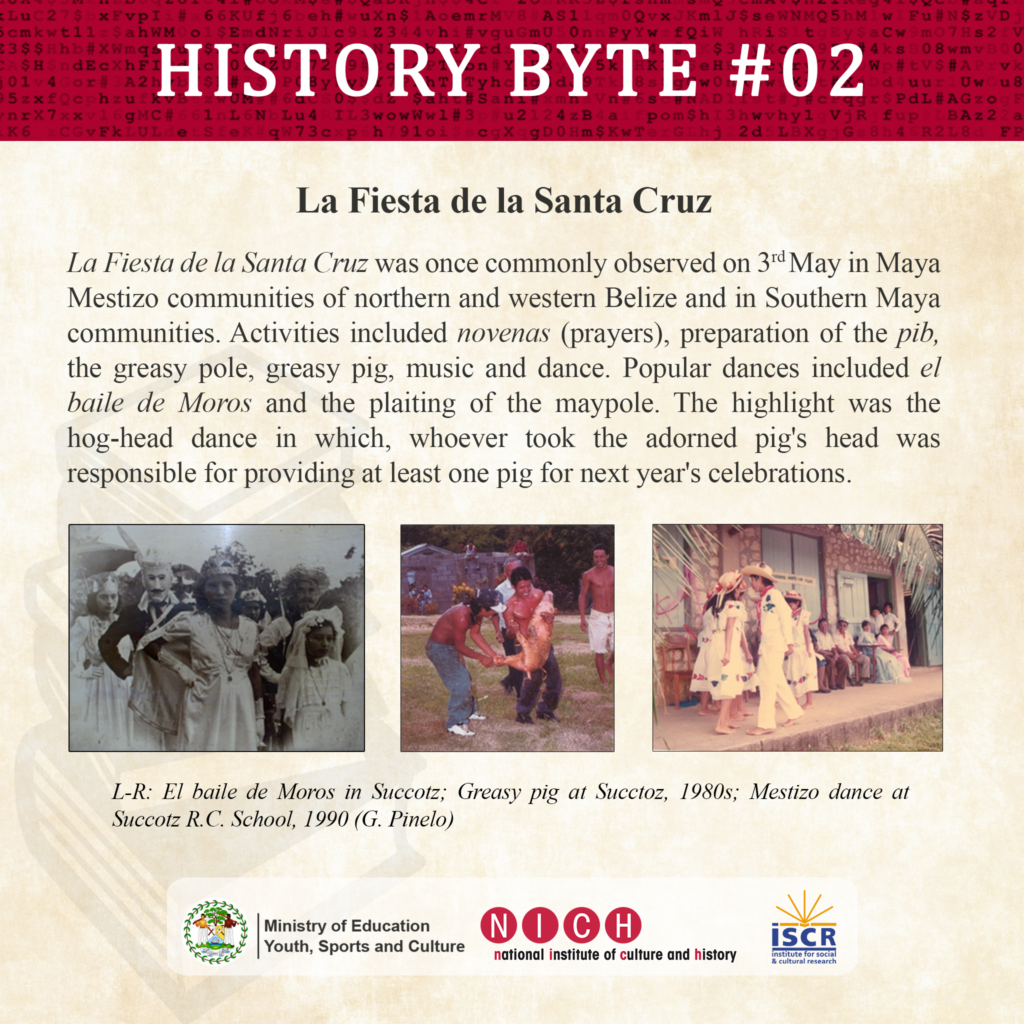
History byte #03: 1972 Cayo Fire
Do you know about the 1972 Cayo fire?
📌The dry climate contributed to the quick spread of the fire leaving approx. 100 persons without homes or personal belongings.
📌The puny but valiant fire fighting brigade was quickly reinforced by men and equipment from Santa Elena and Central when the fire got out of hand.
📌Later reinforcements came from the Augustine Forestry Station, from Benque Viejo, from Belmopan and from Belize City. The Army Garrison at Central Farm sent every available man along with some heavy equipment, and relays of firefighters were flown in from Belize City.
📌Reports say the fire started from the little cook-shop of Miss Rosie Lewis, located near the Shell Service Station and Maya Hotel. The firefighters were able to stop the fire from spreading much beyond the hotel building, but at that stage, the underground tanks of the petrol station erupted. The blast threw one attendant, Emilio Cal some thirty feet downhill into the river below.
📌The Escandar Bedran liquor store and home became engulfed, and, with the exploding butane tanks provided new fuel to the fire.
📌The fire jumped King Street into the triangle facing Columbus Park and burned it flat the ground along with two thatched homes on Benque Road.
📌By the end, there was amazingly no loss of human life.
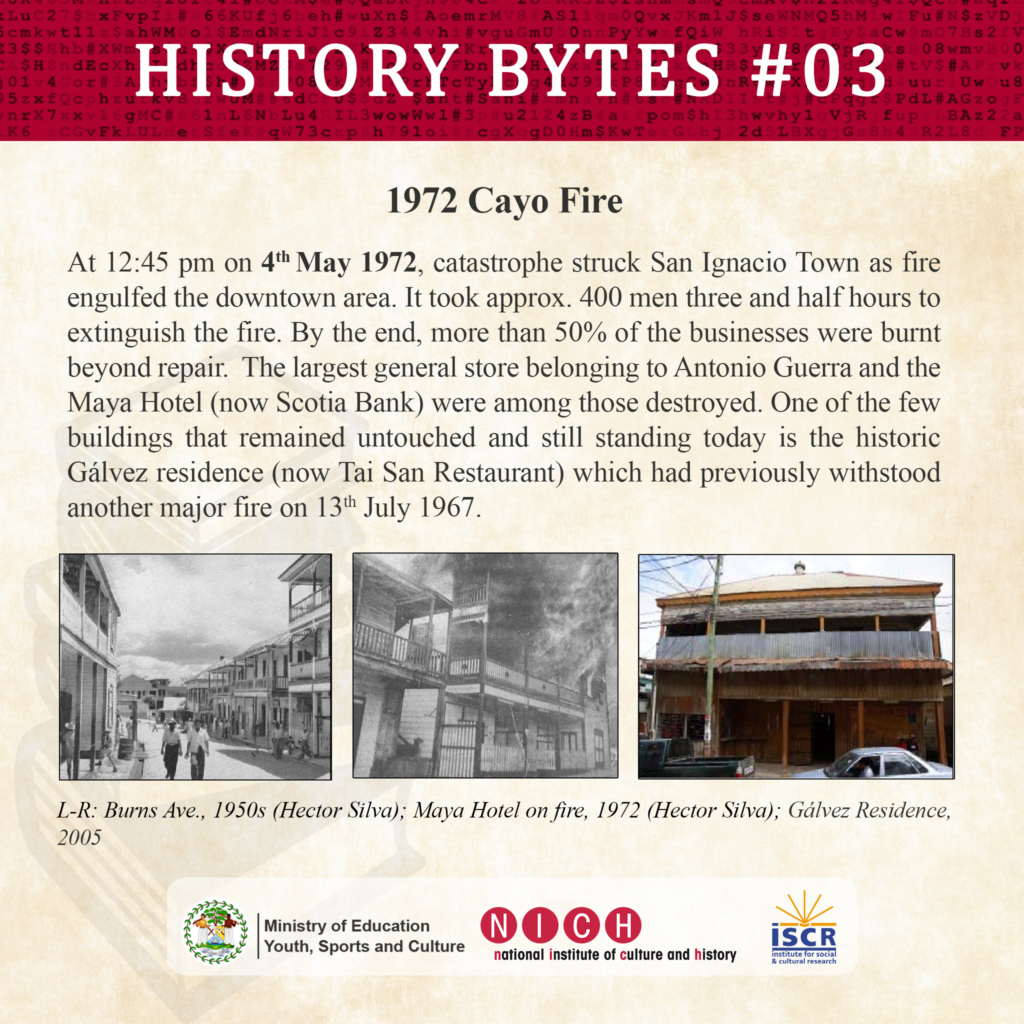
History Byte #04: Stann Creek Railway
Did you know that the location of the Drums of our Fathers Monument was previously the site for the turntable of the Stann Creek Railway?
📌The Stann Creek Railway was originally created to transport timber from the Maya Mountains to the port in Dangriga at the turn of the 20th Century.
📌The construction of the railway was undertaken by the British Colonial authorities, in an effort to deter external control and the formation of “Banana Republics” by the United Fruit Company as was seen across Central America.
📌At the time, Dangriga was the second largest town with a high population and a high number of persons were employed in the area.
📌The major corporations that used the railway and pier include the United Fruit Company, Tidewater Lumber Company, and the American Palm Products Company.
📌The railway eventually fell into disuse as the timber industry declined and the Panama disease affected the banana plantations.
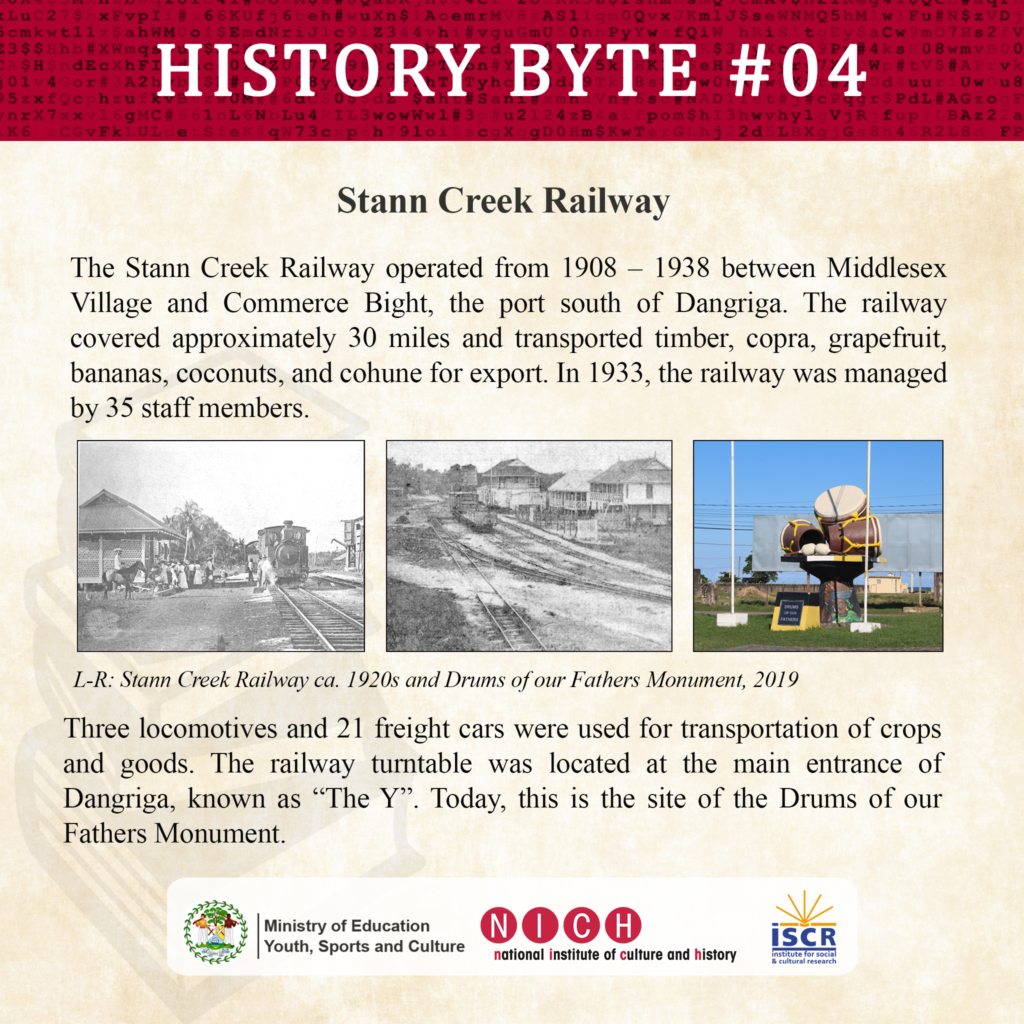
History Byte #05: Yarborough Cemetery
Do you know who is buried at Yarborough Cemetery?
📌Yarborough Cemetery was named after James Dundridge Yarborough originally from South Carolina, USA. He served as a Magistrate in Belize Town.
📌Yarborough donated a part of his plantation at a Public Meeting in 1787 on the condition that it be used specifically as a burial ground.
📌The Yarborough Cemetery replaced the old burial ground on Albert Street.
📌The Yarborough Cemetery was consecrated by the Bishop of Jamaica, Christopher Lipscombe along with St. John’s Cathedral.
📌In 1877, when the Old Yarborough Cemetery was nearly full, the New Yarborough Cemetery was formed a little to the south of the old one, the latter being closed. However, the land in the New Cemetery proved so low that it could not be dug to any depth, and Yarborough Cemetery was closed in 1881.
📌The cemetery has suffered extensive damage over time due to natural disasters and vandalism. The 1931 Hurricane destroyed a row of eucalyptus trees and the 1961 Hurricane Hattie destroyed its white wooden fence.
📌The Yarborough Cemetery is one of Belize’s historic archaeological sites.
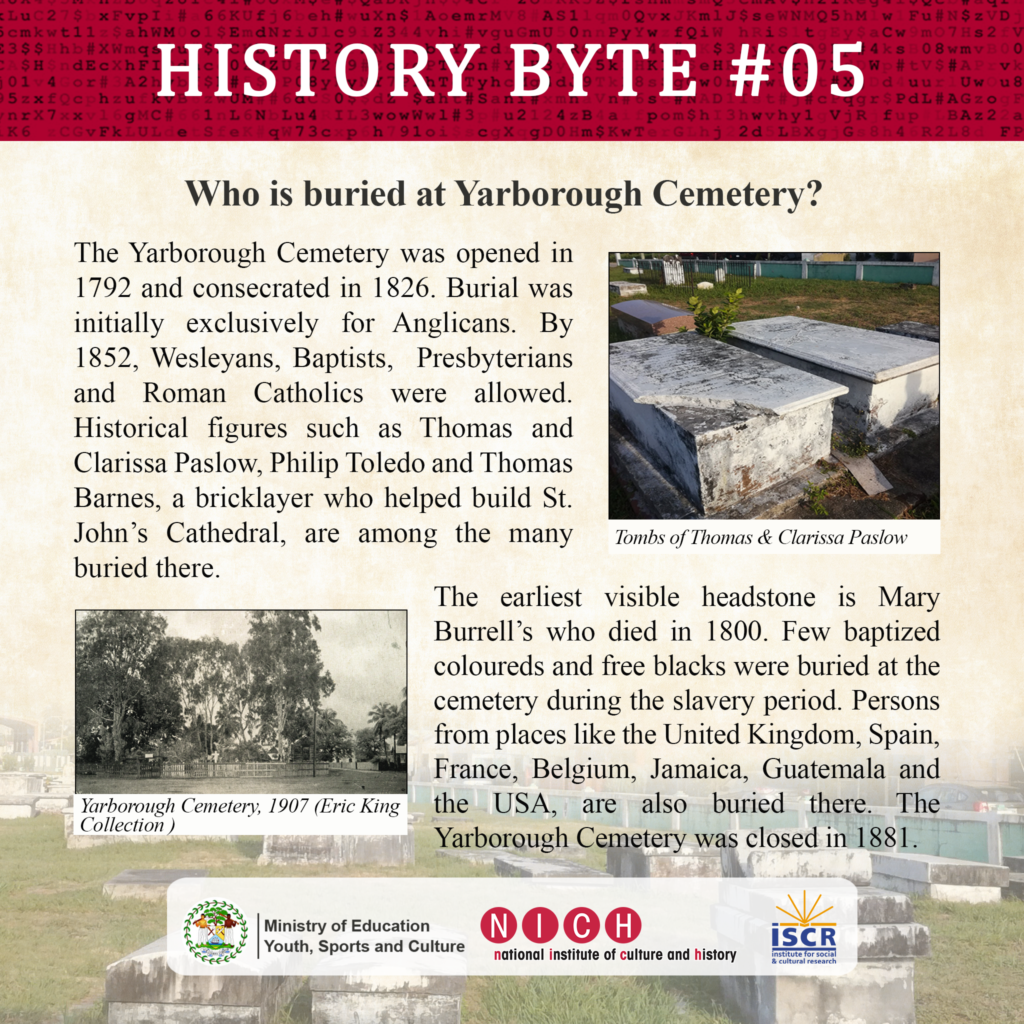
History Byte #06: Peggy’s Punishment
📌In 1807, the Act for the Abolition of the Slave Trade was passed by the British Parliament making the trading of enslaved persons illegal throughout the British Empire.
📌In “Correspondence Relative to Slaves at Honduras 1820 – 1823”, Superintendent Col. George Arthurs wrote a series of letters to England detailing the harsh cruelty suffered by the slaves at the hands of their masters.
📌There were numerous cases similar to Peggy’s. With no formal law in place for the protection of slaves in Belize, the situation became so severe that in September 1821, Superintendent Arthurs was persuaded to proclaim that the Consolidated Slave Law of Jamaica is observed in Belize.
📌In 1833, the Act for the Abolition of Slavery was passed which also provided for the emancipation of enslaved people effective 1 August 1834. Former enslaved persons were required to serve a period of unpaid apprenticeship before receiving full emancipation.
📌In 1838, former enslaved persons were emancipated throughout the British Empire and in Belize.

History Byte #07: District Boundaries
📌The District boundaries of Belize were drawn in line with timber concessions and used for jurisdictional purposes.
📌Up to 1880, there were the Belize, Northern, Western and Southern Districts.
📌In September 1881, the Northern District was separated into Orange Walk and Corozal.
📌 In 1882, the Southern District was divided into the Stann Creek and Toledo districts.
📌Corozal and Orange Walk were amalgamated in 1887 reducing it to five districts.
📌On 23rd May, 1906, the north was again separated.
📌Given its small voting population as per the 1935 Elective Principle, the north was again joined between 1939 and 1950.
📌The last adjustment was in 1954 between the Toledo and Cayo Districts.
📌The Toledo district was redrawn losing approximately 330 sq. miles.
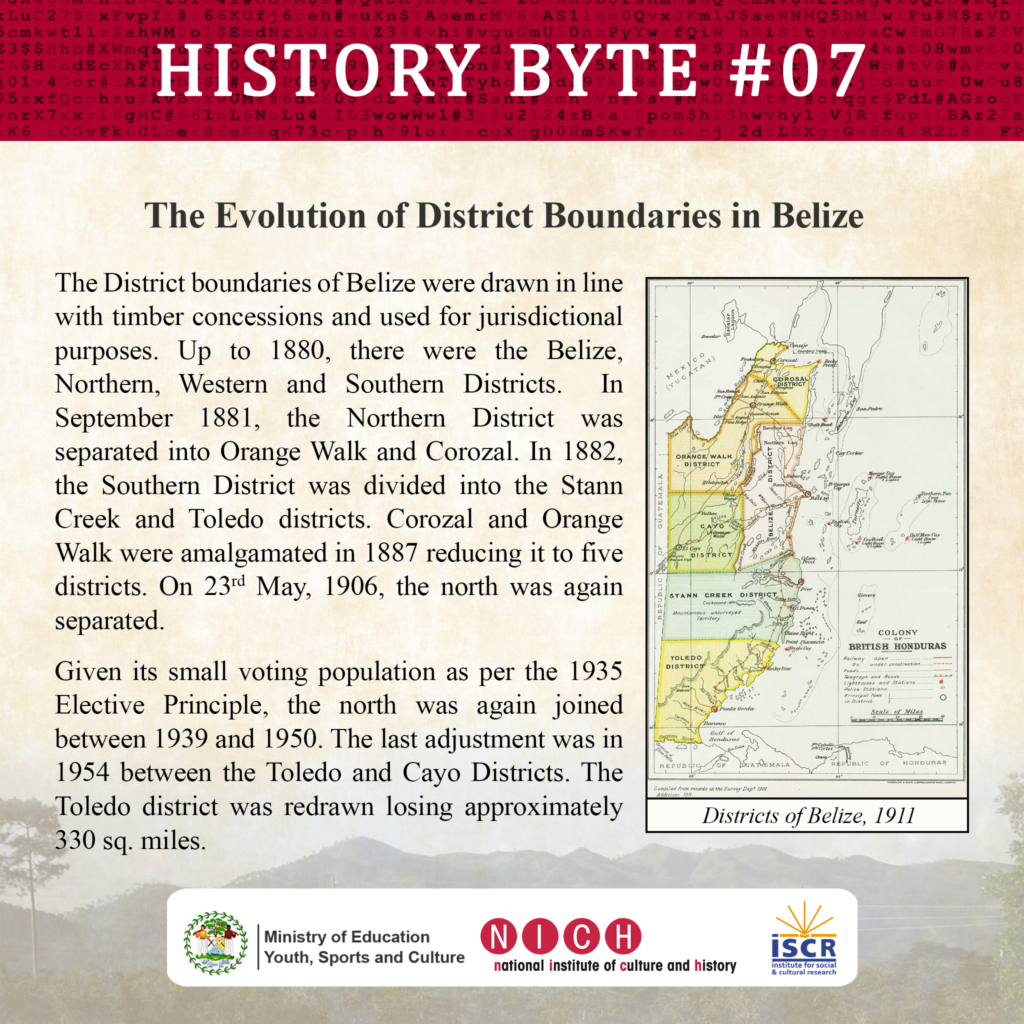
History Byte #08: Commonwealth Day
📌Queen Victoria became queen at age 18 and held one of the longest reigns in British history.
📌Her reign became known as the Victorian Era and was marked by significant economic and industrial development in Britain.
📌Empire Day was officially recognized in 1916. The day was especially celebrated by schools across the British Empire; children would salute the British flag and sing patriotic songs.
📌 As countries that formed the British Empire began to celebrate their own identity, Empire Day was changed.
📌Today, 54 countries form the Commonwealth including countries that were former British colonies and a few that have voluntarily joined the association.

History Byte #09: Commonwealth Day
📌The early settlers of the Belize settlement faced a series of attempts by the Spaniards to expel them during the 1700s.
📌The most successful attempt took place on 15th September 1779.
📌In a surprise invasion, St. George’s Caye and parts of the mainland settlement were captured and destroyed.
📌Almost four hundred persons, including settlers and slaves, were captured and taken to Merida, Yucatan, and then imprisoned in Havana, Cuba.
📌It was not until 1782 that those who survived imprisonment were released and sent to Jamaica.
📌This experience with the Spaniards deeply traumatized those who returned and it would eventually play a part in the decision-making at the 1st June, 1797 Public Meeting. In the face of another Spanish invasion, 51 persons voted for evacuation, and 65 voted to stay and defend Belize.
📌 This encounter would eventually take place on 10th September, 1798— the Battle of St. George’s Caye.
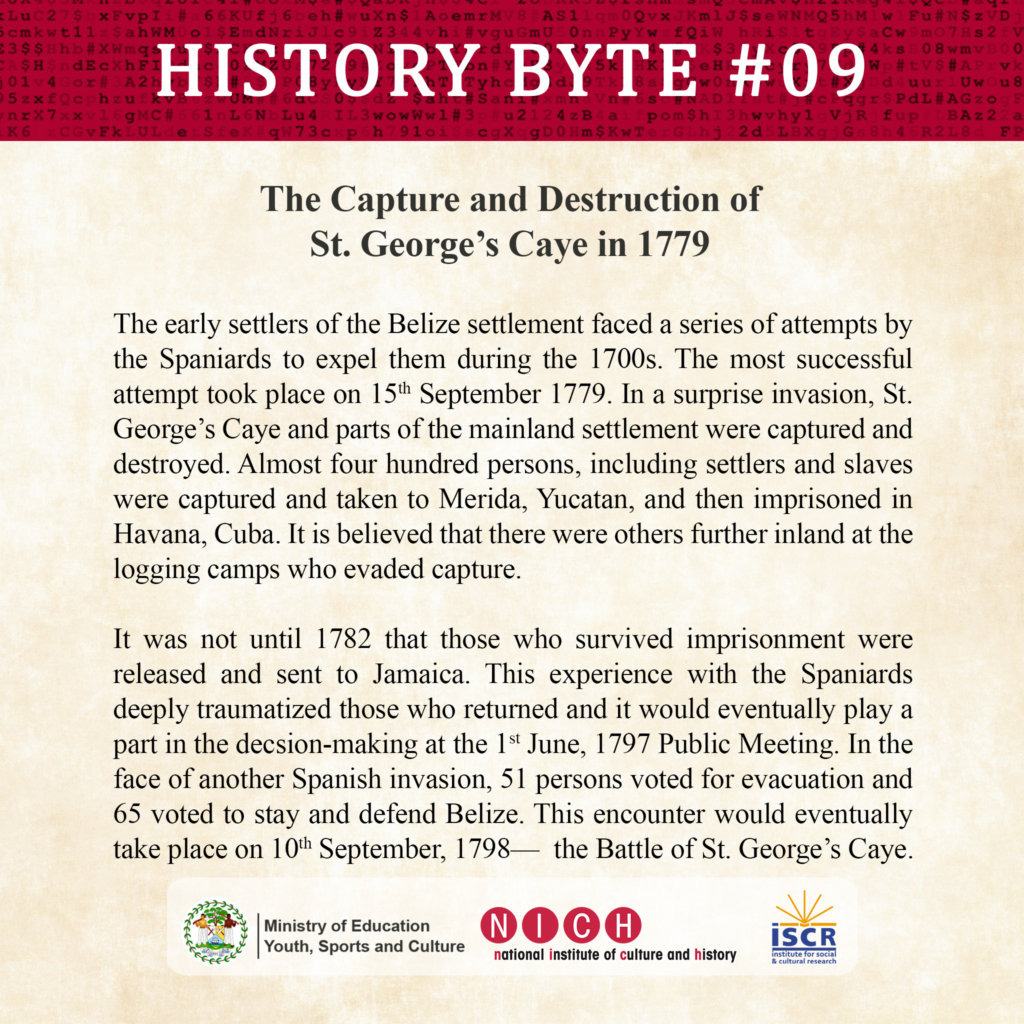
History Byte #10: Commonwealth Day
📌The Why-Not Island in Dangriga Town is named after a sailing lighter of the same name owned by Mr. Sandy Carter in the 1930s.
📌The lighter transported commodities such as rice, sugar, pigtail, and other goods to Dangriga.
📌According to community lore, one morning the lighter drifted with the tide and ran ashore near the market area. While most of the cargo was recovered, the lighter proved difficult to salvage.
📌It was pulled into a nearby brook off the North Stann Creek River.
📌The lighter remained at the site and over the years, seasonal floods which brought debris, silt, and other sediment covered the lighter and the surrounding area.
📌 This patch of land became known as Why-Not Island.

